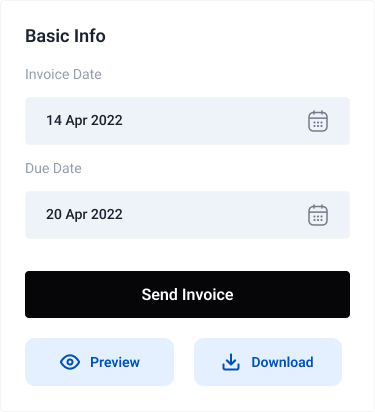Did You Know?
Advanced visual search system powered by Ajax
Advanced visual search system powered by Ajax
As your company expands, it’s crucial to align new opportunities with your vision. To make changes, amend your Memorandum of Association and complete necessary formalities. Fincto offers a seamless service to simplify the process, allowing you to transition smoothly into a new phase
A thorough checklist is crucial for a smooth and efficient winding up of a company.Here are the key steps to take:
As your company expands into new areas and markets, it's crucial to adjust your objectives to align with the evolving business scope
When a new company takes over, it can lead to significant changes, altering the company's direction and vision, necessitating updates to its objectives
Over time, some company activities may become obsolete, making it crucial to update company objectives to reflect these changes
Changes in government policies may render certain activities illegal or restricted. To comply with regulations and avoid legal consequences, updating the company objectives is necessary
Government fees and stamp duty depend on the authorised capital of the company.
The process for changing the company objectives involves five key steps:
The company's name and objectives will be altered through a board meeting, with a director or secretary appointed to sign and certify the necessary documents
File Form MGT-14 with the RoC, along with the necessary documents, to process the changes
After receiving the new incorporation certificate, update the object clause in all copies of the MoA
The committee is planning to hold an Extraordinary General Meeting (EGM) to approve changes, ensuring all members are given proper notice and their responses are collected
If the Company Identification Number (CIN) changes due to a change in the industry code, the RoC will issue a new certificate of incorporation to the company
To initiate the company liquidation process in India, you will need the following documents:
To increase the authorised share capital, the following documents must be filed with the MCA within 30 days of obtaining consent from shareholders:
Liquidation grants directors and company personnel relief from creditor obligations and pressures once the process is complete.
By voluntarily approving the resolution, directors can avoid legal actions initiated against the company, allowing them to focus on new commercial opportunities.
Liquidation expenses are relatively lower as they are primarily associated with the sale of assets.
All lease agreements signed by the company will be terminated during liquidation, along with their terms and conditions.
Creditors benefit from the liquidation process as they are eligible for payment related to the proposed credits provided by all creditors.
Directors must submit KYC information to MCA if they meet recent updates.
Initiated by a special resolution or a resolution passed in a general body meeting, voluntary winding up can be prompted by violating the provisions and conditions of the Memorandum of Association (MOA).
This mode involves winding up the company at the court's command, following a specific resolution passed by the directors or through a petition filed by an official, or if the company engages in illegal or fraudulent activities.
The process of liquidation is governed by several regulations and acts, including:
The act outlines the circumstances under which a company can be shut down, including special resolutions, acts against the country's sovereignty, court findings, failure to file yearly returns, and more.
This code deals with the voluntary liquidation of companies through special resolutions passed by board members.
If a director voluntarily tenders their resignation, the following steps are taken:
If a director is absent from all board meetings for 12 consecutive months without seeking leave, they are considered to have vacated their office as per Section 167. The process involves filing Form DIR-12, and the director's name is removed from the MCA database.
The steps for removal of a director by shareholders are as follows:
A private limited company must adhere to regular compliance requirements throughout its lifecycle. Some reasons for compulsory winding up of a company include:
The company adopts a special resolution directing the tribunal to wind up the business.
Failure to file required reports with the registrar's office.
Failure to commence business within a year of incorporation.
The number of employees falls below the required threshold for a public or private company.
Inability to pay debts and liabilities.
The court's decision deems the dissolution of the company as just and equitable.
Directors must submit KYC information to MCA if they meet recent updates.
The Ministry of Corporate Affairs offers the 'Strike Off' mechanism for inactive businesses, which can be initiated voluntarily through specific resolutions or court orders.
This method, available under Section 248 of the Companies Act of 2013, is a quick and straightforward way to dissolve a defunct company.
Once a liquidator is appointed, the company's owners lose control over the business and its assets.
Although still holding their titles, directors no longer have control over the company's decisions during liquidation.
All assets are sold off to repay creditors as much of the company's debt as possible.
Directors may still be personally liable for debts guaranteed by them, even after the company's bankruptcy.
Depending on the industry, directors may be prohibited from working in the same field for a certain period after the company's bankruptcy.
Businesses must fulfill various compliances, in addition to company compliances.These include:
Private limited companies must prioritize annual compliances, ensuring filings meet due dates and adhering to prescribed guidelines
Manage company income, expenditure, and monitor managerial policies effectively.
Assess business performance using key metrics like net profit.
Monitor business finances for effective project planning and financial management.
Assess a business's financial health and credibility for investors.
Registrar of Companies mandates income tax compliance, avoiding fines.
CSR-1 registration is crucial for NGOs seeking corporate social responsibility (CSR) funding from companies with specific net worth, turnover, or net profit. To initiate the process, NGOs must file Form CSR-1 with the Ministry of Corporate Affairs (MCA), which may require additional documentation or clarifications. Approval grants NGOs the CSR-1 registration certificate, paving the way for securing CSR funding from companies. This one-week process is essential for NGOs in the CSR funding realm.
The Director Identification Number (DIN) is a crucial identifier for aspiring and current directors in corporate governance. Obtaining a DIN requires a one-time application through eForm DIR-3. An annual requirement has been introduced, requiring directors with DINs to submit KYC details annually through fincto’s expertise.
THIS FOUNDERS’ AGREEMENT (hereinafter referred to as the ‘Agreement’) is executed on [DD/MM/YYYY] by and among [XXXX] (the ‘Company’), and the following founders (the ‘Founders’):
[Insert Founder Name]
[Insert Founder Name]
NOW, WITH DUE CONSIDERATION to the foregoing and the mutual covenants and agreements hereinafter detailed, the parties hereto concur as follows:
[Continuation of the founders agreement template, incorporating company information, initial capital, ownership structure, vesting schedule, intellectual property rights, amendment protocols, resignation procedures, confidentiality commitments, dispute resolution, and more.]
Fincto combines technology and legal expertise for thousands of legal tasks.
Government processes simplified for convenience.
Package includes two iterations for satisfaction.
Fincto simplifies legal processes, making them accessible and accessible.
For comprehensive guidance, expert consultation is recommended.
A founders agreement encompasses several pivotal sections, including:
Identifying co-founders and their roles within the company.
Defining equity ownership distribution and percentage among co-founders.
Potential inclusion of a vesting timetable for equity shares.
Managing intellectual property rights in business ventures.
Outlining decision-making mechanisms, roles, and responsibilities of co-founders.
Describing scenarios leading to termination and exit procedures for co-founders.
Establishing protocols for dispute resolution, including mediation and arbitration.
Customer may receive a refund for product dislike, damaged, incorrect item, or predefined issues upon return.
Refund policy governs online order cancellation process, details, and procedures for refunds.
A Website Disclaimer communicates liabilities to visitors, safeguards intellectual property, discourages unauthorized usage, and prevents misuse accusations. It can be standalone or integrated into legal documents, demonstrating responsible online conduct and promoting responsible behavior.
A Cookie Policy is essential for online transparency and legal compliance, educating visitors about active cookies, their purpose, and user data processing. It is often a legal requirement in many jurisdictions.
E-commerce relies on efficient shipping and delivery; a Shipping Policy provides clear information on fees, timelines, and procedures, improving customer experience.
GSTR1 is the form used for tax returns on outward supplies, encompassing both interstate and intrastate B2B and B2C sales. It also includes details of purchases under reverse charge and inter-state stock transfers made during the tax period. Late filing of GSTR1 can result in a late fee, which is collected in the subsequent open return, Form GSTR-3B. Since January 1, 2022, taxpayers cannot file Form GSTR-1 if they haven't filed Form GSTR-3B in the preceding month.
This amendment form corrects any discrepancies between the GSTR-1 of a taxpayer and the GSTR-2 of their customers. The filing window for GSTR1A is between the 15th and 17th of the following month.
Monthly GST returns for inward supplies are filed using this form. It contains taxpayer information, return period, and detailed invoice-level purchase information related to goods and services separately.
This auto-generated tax return compiles purchases and inward supplies made by a taxpayer based on the information from their suppliers GSTR-1.
An auto-generated document that acts as an Input Tax Credit (ITC) statement for taxpayers, facilitating faster return filing, minimizing errors, easing reconciliation, and simplifying compliance.
This form is used to file consolidated monthly tax returns. It contains the taxpayers basic information, turnover details, final aggregate-level inward and outward supply details, tax liability under CGST, SGST, IGST, additional tax (+1% tax), ITC, cash, liability ledgers, and details of other payments like interests, penalties, and fees.
This is a tax notice issued by the tax authority to a defaulter who has failed to file monthly GST returns on time.
It is a temporary consolidated summary GST return for inward and outward supplies, introduced as a relaxation for recently registered businesses.
This quarterly GST return is filed by compounding vendors. It includes the total value of supplies made during the covered period and details of tax paid at the compounding rate (not exceeding 1% of aggregate turnover) along with invoice details for inward supplies.
The Quarterly purchase-related tax return filed by composition dealers, automatically generated by the GSTN portal based on information from the suppliers GSTR-1, GSTR-5, and GSTR-7.
Variable return for Non-resident foreign taxpayers, containing details of the taxpayer, return period, and invoice details of all goods and services sold and purchased. It also includes imports on Indian soil for the registered period/month.
This monthly GST return is for ISDs (Input Service Distributors), containing details of invoice-level supply from the GSTR-1 of counterparties, credit for ITC services received, debit for ITC reversed or distributed, and closing balance.
It is a monthly return for TDS (Tax Deducted at Source) transactions, containing the taxpayers basic information, return period, supplier's GSTIN, and invoices against which the tax has been deducted, categorized under SGST, CGST, and IGST. It also includes details of other payments like interests and penalties.
This is the monthly return for e-commerce operators. It contains the taxpayers basic information, return period, details of supplies made to customers through the e-commerce portal, tax collected at source, tax payable, and tax paid.
The annual consolidated tax return, comprising detailed income and expenditure, regrouped according to the monthly GST returns filed by the taxpayer.
The annual composition return form to be filed by every taxpayer enrolled in the composition scheme.
This Audit form is filed by taxpayers liable to get their annual reports audited when their aggregate turnover exceeds ₹2 crores in a financial year.
Filed before cancelling GST registration, this final GST return contains the details of all supplies, liabilities, tax collected, and tax payable.
Variable tax return for taxpayers with UIN (Unique Identification Number), containing details of purchases made by foreign embassies and diplomatic missions for self-consumption during a particular month.
Entrust your Form DIR-3 KYC submission to fincto for a stress-free, seamless process, allowing you to focus on core responsibilities as a director. Fincto embodies excellence in compliance, ensuring compliant and confident directorship.
Staying compliant with GST due dates is vital to avoid late payment charges and interests. Fincto provides updated information on due dates for the financial years 2021-2022 and 2022-2023. Keeping clients informed of these updates can help taxpayers stay on top of their compliance requirements and ensure timely filing of GST returns.
Taxpayers registered under the Composition Scheme must file taxes using CMP-08 every quarter and file GSTR-4 annually. The due date for the GST return for Composition Scheme registrants is the 18th of the month following each quarter.
Fincto provides a hassle-free GST return filing experience with the support of a team of dedicated experts. Fincto offers a seamless GST compliance journey. It's commendable to see such dedication to assisting taxpayers in their GST return filing processes.
A GST Certificate is an important document issued by the Indian government which proves that a business is registered under GST. The certificate contains crucial information like the GST identification number, name, and address of the business. With a GST Certificate on hand, businesses can easily charge and collect GST, apply for loans, and participate in tenders.




Fincto offers a simple, speedy process for changing company objectives, including expert guidance, assistance in adding main and ancillary objectives, draft and fill resolutions, timely amendments to MoA, and excellent support for queries.
Mattis turpis in suspendisse sed risus nulla adipiscing augue pellentesque nam mi tellus consectetur

Gerry Kellmen
Head of financeMattis turpis in suspendisse sed risus nulla adipiscing augue pellentesque nam mi tellus consectetur
Johnson
WordPressMattis turpis in suspendisse sed risus nulla adipiscing augue pellentesque nam mi tellus consectetur
Maxwell
PHP DeveloperMattis turpis in suspendisse sed risus nulla adipiscing augue pellentesque nam mi tellus consectetur
Anderson
Head of financeBanca is a leading bank in the worldzone and a prominent international banking institution
COTATION
2023-01-05 14:00 (INTERNATIONAL TIME)